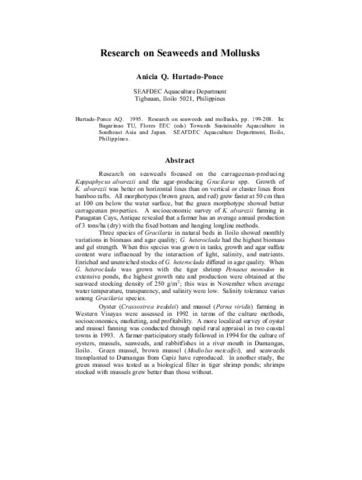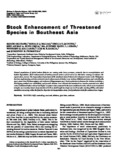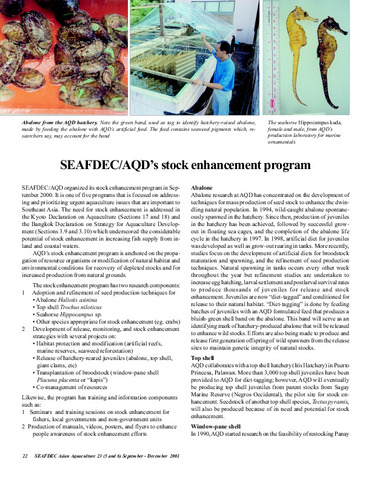Aquaculture-based Enhancement and Restoration of Many-colored Abalone Resources (Haliotis diversicolor Reeve, 1846) in Bach Long VI National Marine Protected Area, Vietnam
Share
Abstract
Many-colored abalone (Haliotis diversicolor) is high commercial species in Vietnam. Meanwhile, these resources have been over-exploited, thus, artificial breeding was implemented to restore natural abalone resources. After sourcing the broodstock, many-colored abalones were stimulated to reproduce during October -December 2013 at the Abalone Seed Center in Bach Long Vi, Hai Phong City. The results showed that veliger larvae developed from 11h - 36h after breeding. Abalone juveniles reached to 4.5 mm (shell length) at the age of 42 days. Survival rate of abalone juveniles 1-2 mm (28 days old) was 0.92%, 3.80%, and 24.00% at larvae densities 7.5, 6.8, and 1.6 larvae/cm super(2) algae board, respectively. After 2 months (October - November), 30,000 juveniles of 4.5 mm shell length; 33,800 juveniles of 3 mm shell length; 45,500 juveniles of 2 mm shell length; and many small larvae were collected at the Bach Long Vi Abalone Seed Center. More than 6,000 juveniles of 4.5 mm shell length were released to Bach Long Vi National Marine Protected Areas for conservation in April 2014. The restoration assessment was briefly carried out in June 2015, and found that almost all individuals were found to have average shell length of 3.4 cm in Bach Long Vi National Marine Protected Area. This is an initial achievement of aquaculture and juvenile rearing to release and protect the many-colored abalone resources in Viet Nam.
Suggested Citation
Chieu, H. D., Phuong, L. D., Duy, D. A., Tuan, B. M., & Thoa, N. K. (2016). Aquaculture-based enhancement and restoration of many-colored abalone resources (Haliotis diversicolor Reeve, 1846) in Bach Long Vi national marine protected area, Vietnam. In H. Kawamura, T. Iwata, Y. Theparoonrat, N. Manajit, & V. T. Sulit (Eds.), Consolidating the Strategies for Fishery Resources Enhancement in Southeast Asia. Proceedings of the Symposium on Strategy for Fisheries Resources Enhancement in the Southeast Asian Region, Pattaya, Thailand, 27-30 July 2015 (pp. 174-176). Samutprakan, Thailand: Training Department, Southeast Asian Fisheries Development Center.
Subject
stocking density  ; survival
; survival  ; induced ovulation
; induced ovulation  ; fishery resources
; fishery resources  ; restoration
; restoration  ; breeding
; breeding  ; overexploitation
; overexploitation  ; protected areas
; protected areas  ; commercial species
; commercial species  ; breeding stock
; breeding stock  ; seed (aquaculture)
; seed (aquaculture)  ; juveniles
; juveniles  ; seeds
; seeds  ; stocking (organisms)
; stocking (organisms)  ; shellfish culture
; shellfish culture  ; stock assessment
; stock assessment  ; larvae
; larvae  ; seed production
; seed production  ; length
; length  ; depleted stocks
; depleted stocks  ; nature conservation
; nature conservation  ; marine parks
; marine parks  ; marine molluscs
; marine molluscs  ; stocks
; stocks  ; reproduction
; reproduction  ; Algae
; Algae  ; South East Asia; Viet Nam; Haliotis; Haliotis diversicolor
; South East Asia; Viet Nam; Haliotis; Haliotis diversicolor
 ; survival
; survival  ; induced ovulation
; induced ovulation  ; fishery resources
; fishery resources  ; restoration
; restoration  ; breeding
; breeding  ; overexploitation
; overexploitation  ; protected areas
; protected areas  ; commercial species
; commercial species  ; breeding stock
; breeding stock  ; seed (aquaculture)
; seed (aquaculture)  ; juveniles
; juveniles  ; seeds
; seeds  ; stocking (organisms)
; stocking (organisms)  ; shellfish culture
; shellfish culture  ; stock assessment
; stock assessment  ; larvae
; larvae  ; seed production
; seed production  ; length
; length  ; depleted stocks
; depleted stocks  ; nature conservation
; nature conservation  ; marine parks
; marine parks  ; marine molluscs
; marine molluscs  ; stocks
; stocks  ; reproduction
; reproduction  ; Algae
; Algae  ; South East Asia; Viet Nam; Haliotis; Haliotis diversicolor
; South East Asia; Viet Nam; Haliotis; Haliotis diversicolor
Related items
Showing items related by title, author, creator and subject.
-
Research on seaweeds and mollusks
Hurtado-Ponce, Anicia Q. (Aquaculture Department, Southeast Asian Fisheries Development Center, 1995)Research on seaweeds focused on the carrageenan-producing Kappaphycus alvarezii and the agar-producing Gracilaria spp. Growth of K. alvarezii was better on horizontal lines than on vertical or cluster lines from bamboo ... -
Stock enhancement of threatened species in Southeast Asia
Okuzawa, Koichi; Maliao, Ronald J.; Quinitio, Emilia T.; Buen-Ursua, Shelah Mae A.; Lebata, Ma. Junemie Hazel L.; Gallardo, Wenresti G.; Garcia, Luis Maria; Primavera, Jurgenne (Taylor & Francis, 2008)Natural populations of global inshore fisheries are coming under heavy pressure, primarily due to overexploitation and habitat degradation. Stock enhancement of hatchery-reared seeds is perceived as an alternative strategy ... -
SEAFDEC/AQD's stock enhancement program
Castaños, Milagros T.; Southeast Asian Fisheries Development Center, Aquaculture Department (Aquaculture Department, Southeast Asian Fisheries Development Center, 2001)




